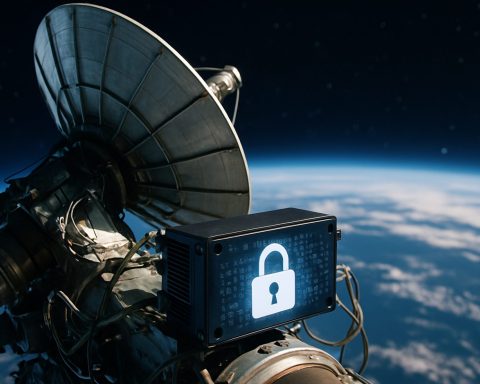- Chinese automaker BYD announces a breakthrough charging technology, delivering 249 miles of range in five minutes, shaking the EV market.
- This innovation triggers a 6% increase in BYD’s stock, highlighting market impact.
- Global EV and hybrid sales are expected to rise 25% to 17 million in 2024, reflecting rapid industry growth.
- BYD’s advancement addresses “charging anxiety,” aiming to transform the EV adoption landscape.
- BYD and Tesla lead global EV sales, intensifying competition with promising, competitively priced models.
- Trade tariffs challenge U.S. consumers, but competitive pricing could make EVs more accessible soon.
- Environmental benefits include reduced emissions and cleaner cityscapes, aligning with climate goals.
- Success depends on achieving a balance of fast charging, range, convenience, and accessibility.
- Tax incentives and innovation signal a promising shift towards sustainable transportation.
In the ever-evolving race for electric vehicle supremacy, a charge of change is sweeping through the streets—and it’s driven by none other than Chinese automaker BYD. With a bold claim that rattles the industry, BYD announces a charging technology that reportedly powers up an electric vehicle (EV) to a range of 249 miles in a mere five minutes. This innovation, if rolled out successfully, not only sets a new benchmark for efficiency but also sends shockwaves through stock markets, nudging BYD’s shares up by a striking 6%.
As it stands, BYD and Tesla are titans of the EV world, responsible for a staggering one-third of global EV sales. The stakes soar even higher with global EV and hybrid vehicle sales climbing 25% to 17 million in 2024, underscoring the industry’s rapid growth. BYD’s charging promise could dismantle one of the last bastions holding back the potential flood of new EV adopters—the dreaded “charging anxiety.”
Imagine leaving home, a blip of anxiety about charging time brushing against your mind. In a world where every second is precious, BYD’s audacious leap reduces charging time to a mere glance, making it competitive with traditional fuel stops. Gone are the days of pondering over where and when to plan your next charge.
What’s more fascinating is the competitive dynamic between BYD and Tesla. Both companies dance on the edge of innovation, pushing the envelope further with models priced competitively. While BYD’s Dolphin captures markets at below $30,000, Tesla is on the cusp of offering a similarly enticing option come 2025. For American consumers, the electric evolution feels tantalizingly close yet slightly out of reach, stymied by complex trade tariffs. But ever-pressing innovation and competitive pricing might soon turn the tables.
Beyond commerce, there lies an environmental narrative—a promise of cleaner cityscapes and purer air. As BYD prepares to deploy its fleet of “flash-charge” stations across China and potentially beyond, the impact on our planet’s health could be profound. Cutting greenhouse gases aligns with global efforts to combat climate change, with institutions like the American Lung Association advocating for reduced emissions to protect public health.
Yet not all voices are solely electrified by speedier charging. Some industry insights remind us that while faster charging is thrilling, it is the balance of range, convenience, and accessibility that truly wins hearts.
As this new chapter unfolds, many await to see how competition and adoption shape the future of transportation. With tax incentives making EV ownership more appealing stateside, the electrifying promise of innovation and sustainability seems no longer a far-off dream but a fast-approaching reality.
In the bustling backdrop of ever-present innovation, both tech enthusiasts and environmentalists find themselves united under the compelling rhythm of progress that hums with the promise of a bright, sustainable tomorrow.
Charging Into the Future: BYD’s Revolutionary Technology Set to Transform the EV Landscape
Introduction
The global electric vehicle (EV) industry is buzzing with excitement as Chinese automaker BYD announces a groundbreaking advancement: a charging technology capable of powering an EV up to a range of 249 miles in just five minutes. This innovation could potentially reshape the market, addressing one of the major hurdles facing widespread EV adoption—charging time.
Unpacking BYD’s Charging Breakthrough
How Does It Work?
BYD’s new charging technology leverages advancements in battery chemistry and infrastructure to drastically reduce charging times. It likely involves higher charging power and thermal management systems to manage the battery’s temperature, ensuring safety and efficiency.
Technologies like solid-state batteries, which have higher energy density and faster-charging capabilities, may play a role in these improvements. These batteries are smaller, lighter, and have a reduced risk of overheating.
The Competitive Landscape
BYD’s entry into rapid charging epitomizes the competitive dynamic with Tesla, well-known for its Supercharger network. Both companies control around one-third of global EV sales, pushing each other to innovate swiftly. As BYD debuts budget-friendly models like the Dolphin for under $30,000, Tesla is also expected to release similarly priced vehicles by 2025.
The rivalry is especially pronounced in the American market, where tariffs have impeded broader access to affordable EVs. However, ongoing developments might soon tip the scales, significantly boosting the accessibility of efficient electric vehicles.
Market Trends and Predictions
The electric and hybrid vehicle market is on a significant upward trajectory, with sales expected to reach 17 million by 2024—a 25% increase. BYD’s charging innovation could be a catalyst for even faster growth, diminishing “charging anxiety” and making EVs more appealing.
Emphasizing sustainability, many automakers, including BYD, are focusing on reducing emissions. Coupled with a rise in public charging infrastructure, this shift could foster cleaner urban environments and address climate change challenges.
Real-World Use Cases and Benefits
– Reduced Charging Times: For consumers, the freedom to recharge an EV in only five minutes is revolutionary. This capability puts EVs on par with traditional combustion engine vehicles in terms of convenience for long travels.
– Economic Impact: Faster charging stations across key locations can stimulate economic growth, creating jobs in manufacturing, installation, and maintenance of these hubs.
– Environmental Benefits: Shorter charging durations translate to decreased energy consumption per charge cycle, contributing to a lower carbon footprint.
Potential Controversies and Limitations
However, rapid charging technologies are not without their challenges. Battery lifespan and degradation from frequent fast charging remain concerns. Additionally, the infrastructure required to support such speedy recharges demands significant investments and technological upgrades.
Expert Insights and Recommendations
– Adopt Cautiously: While the technology is promising, consumers and industries should adopt a balanced view, considering the full life cycle of EVs and their components.
– Invest in Infrastructure: Governments and companies should prioritize developing the necessary infrastructure to support this advancement, ensuring access to rapid charging stations is widespread and equitable.
– Stay Informed on Tech Developments: With rapid changes in technology, keeping abreast of updates and innovations in battery tech and sustainability practices is crucial for consumers and investors alike.
Conclusion & Quick Tips
BYD’s technological leap is poised to challenge the status quo, fostering an era where charging anxiety may become a relic of the past. For those considering the shift to EVs, this is an exciting time to explore options. Look for:
– Locations with Charging Infrastructure: Plan routes and cities with good access to fast charging stations.
– Tax Incentives: Take advantage of government incentives for EV purchases.
– Comparative Reviews: Explore reviews and comparisons of EV models to find the best balance of cost, range, and charging convenience.
For more information, explore articles and updates on electric vehicles from leading industry analysts at InsideEVs and EV Volumes.
Armed with these insights, prospective EV adopters can confidently navigate the transitioning landscape toward a greener future.







